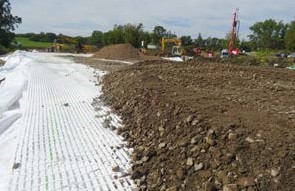
The German federal highway B91 between the cities of Deuben and Werschen in Germany is a collector road with access to the A9 motorway. The subsoil risks resulting from past lignite mining activities represent an enormous challenge in the region. Subsidence has occurred regularly.
Solution
In the area of a bridge abutment, concrete piles were combined with wick drains and a geogrid-reinforced load transfer platform (LTP) to solve the subsidence problem. In the remaining area of the bridge approach ramp, a combination of wick drains together with geogrid-reinforced preloading was chosen.
When choosing the soil improvement solution, the client, DEGES Deutsche Einheit Fernstraßenplanungs- und -bau GmbH, the geogrid’s tensile strength of 885,075 pound-force per foot (1,200 kN/m) in main strength direction of Secugrid HS from NAUE played a decisive role in their decision making.
Geologically, the area of Werschen is in the southern area of the Leipzig lowlands, in particular in the Zeitz-Weißenfels brown coal basin. A comprehensive geotechnical report was prepared prior to the construction work. This resulted in a wide choice of possible soil improvement measures.
Since September 2020, a 591 foot (180 m) long section of roadway requires a complex embankment construction as part of “Lot 3” of the construction works.
To mitigate the risk of mining subsidence causing damage to the new road surface, concrete piles were installed in the area of the planned bridge abutments at a center-to-center distance of 5.2 feet (1.6 m) in combination with wick drains. A 1.6 foot (0.5 m) thick granular drainage layer and the decisive load transfer platform (LTP) were installed on top of the pile caps. The LTP spans the soft subgrade and transfers loads toward the concrete piles into the firm stratum.
The LTP consisted of a Secugrid HS geogrid and a 1.6 foot (0.5 m) thick granular base course. Secugrid HS is a laid geogrid made of high-tenacity polyester multifilaments (PET) with an extruded polyethylene protective coating and welded junctions.
To ensure the integrity of the LTP, it was wrapped into a Secutex nonwoven separation and filtration geotextile. This prevents mixing of varying grain fractions in the transition zone between the granular base course and the in-situ subgrade. The LTP was then covered with embankment fill material and a layer of 1 foot (0.3 m) of qualified soil improvement as foundation for the unbound layers of the road superstructure.
In the area outside the bridge approach ramp, wick drains were installed to improve the subgrade in combination with the high-strength basal reinforcement geogrid. A temporary 4.9 foot (1.5 m) high preload was installed prior to the base course and the roadway superstructure, to accelerate consolidation processes and further reduce post-construction settlement potential. Five horizontal inclinometers were installed along different axes of the road embankment to allow continuous monitoring of long-term settlements of the embankment.
Project Highlights
Expansion of the federal highway between Deuben and Werschen Weißenfels (Saxony-Anhalt), Germany
CONTRACTORS
Naumburger Bauunion GmbH & Co., Teuchern, Germany
Bauunternehmung KG, Görschen, Germany
CLIENT
DEGES Deutsche Einheit Fernstraßenplanungs- und -bau GmbH
GEOSYNTHETICS PRODUCTS
NAUE Secugrid HS 200/200 Q6
NAUE Secugrid HS 1000/100 R6
NAUE Secugrid HS 1200/100 R6
NAUE Secutex 251 GRK 4 C
 TEXTILES.ORG
TEXTILES.ORG


